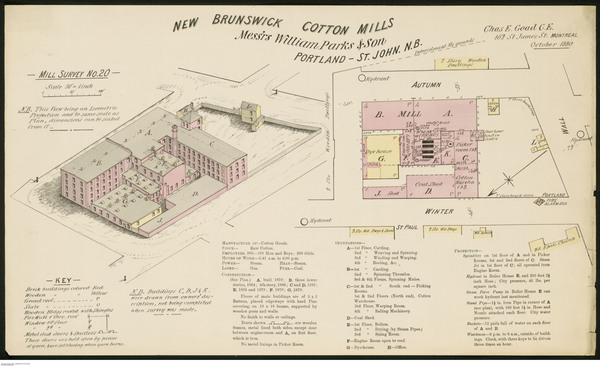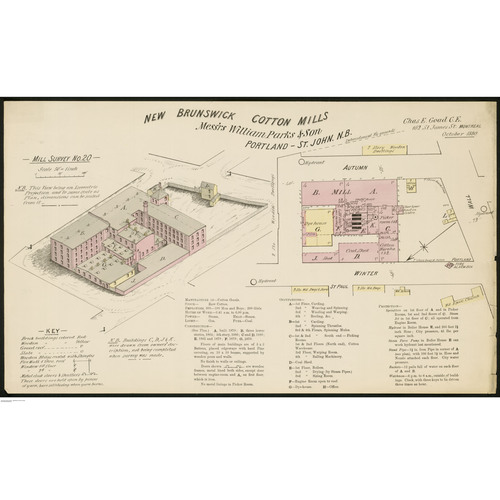
Source: Link
PARKS, JOHN HEGAN, civil engineer and manufacturer; b. 9 Sept. 1836 in Portland (Saint John), N.B., second son of William Parks* and Ann Hegan; m. 29 Jan. 1863 Margaret Ketchum, and they had nine children; d. 7 Sept. 1903 in Saint John.
John Hegan Parks was born and educated, worked, and died in the city of Saint John. After attending the Saint John Grammar School, he was apprenticed for four years to Alexander Luders Light*, chief engineer of government railways in New Brunswick. In 1861, following this training in civil engineering, during which he worked on the building of the Intercolonial Railway, he joined his father’s thriving shipping business at a critical juncture.
William Parks had left Ireland for Saint John in 1822, and by 1828 he had established a partnership there with his brother-in-law John Hegan. Over the years their firm was involved in groceries, dry goods, and shipping. After the partnership was dissolved in 1846, William, together with his eldest son, Samuel (1823–63), took over the shipping end of the business as William Parks and Son, and made a name for himself as one of Saint John’s great merchants. On joining the business, John’s first assignment was to go to England to purchase machinery for the small steam-powered cotton mill on Wall Street in Portland that his father hoped would win a place in a domestic market dominated by British imports. The New Brunswick Cotton Mill (or Mills) was a bold undertaking. To be sure there had been cotton mills in British North America since the 1840s and at least one may have preceded the Wall Street operation in the Maritimes, but the Parks mill was among the first successful domestic cotton mills.
Although it is often said that the early cotton industry in British North America was a by-product of the American Civil War, the fact that effective rates of protection on cotton goods in New Brunswick and Canada were increased in the 1850s offers a more satisfying explanation for its rise. Certainly, for the Parks mill the blockade of the South’s cotton ports and the consequent “scarcity and expense of the raw material” were a drain on the new enterprise. Success was not secured till the end of the war and the coming of confederation. With the elimination of tariffs on interprovincial trade in manufactures, quality yarns from the Parks mill found a market in Montreal. William Parks did not live long to enjoy this accomplishment. He died in a shipwreck off Sable Island and John Parks assumed full control of the firm in 1870.
Under his direction the business grew rapidly. In 1870 the mill’s capacity, as measured in the number of spindles installed, tripled and by 1881 it had tripled again. The National Policy encouraged Parks both to expand the Wall Street mill and to set up a limited liability company, with capital of $200,000 and himself as president, to build and operate a second mill, at Courtenay Bay, the Saint John Cotton Company Limited. The mill was completed in June 1882, but by this time the protectionist boom was nearly spent. In 1883 the industry sank into deep depression. Annual profits at the Wall Street mill tumbled from $45,000 to $1,350, and the Courtenay Bay company paid no dividends.
In 1884 William Parks and Son suspended operations and another limited liability company was formed to save the business. Parks was named president and his son William a director of William Parks and Son Limited. The firm, however, continued to suffer financial difficulties. Ownership was temporarily lost to a creditor, John Ferris of Boston, in 1885, and the Saint John Cotton Company was placed in liquidation and eventually sold to Parks’s brother-in-law Ezekiel Barlow Ketchum. In 1887 Parks, through William Parks and Son Limited, was able to buy back control of the Courtenay Bay mill. Yet he was never able to free the two mills completely from the grasp of local creditors or threat of capture by outside interests. In 1889 the firm was again in crisis. In Montreal cartels were re-forming into trusts [see Andrew Frederick Gault], and it was rumoured that either Montreal capital or an English syndicate was on the scent of the Saint John cotton mills. Parks was reported to have declared in 1891 “that no syndicate shall get hold of his mills if he can help it.” The price of his declaration came two years later when he gave up financial control of the firm to George A. Schofield, a local banker, in return for a $200,000 mortgage provided by Simeon Jones and W. W. Turnbull of Saint John.
In the winter of 1899 the mills were closed. By 1901 Jones and Turnbull had had enough. The outstanding debt on the mortgage stood at $130,000, other debts at $85,000, and liquid assets at only $40,000. They threatened to foreclose to secure their investment. Remarkably, Parks and the other directors of the company were able to persuade them to re-finance their first mortgage with a second of $100,000. But by the close of the year the cotton mills had been sold at auction to a group of local businessmen led by James F. Robertson. After 40 years in the cotton industry, John Parks ceased to play a role in the direction of the mills. However, he continued to head up William Parks and Son until his death.
Outside the cotton industry Parks’s interests were varied. He had served, for example, as a director of the Saint John Gas Light Company and “other organizations of a public character.” He had also been a member of the Portland town council and in 1890 had run as a candidate for the provincial legislature. He took a “deep interest” in the militia, serving with the New Brunswick Engineer Company and rising to the rank of major. For many years he was also president of the New Brunswick Provincial Rifle Association. Like his father he was a Protestant, attending St Stephen’s Church (Presbyterian) in Saint John.
Following a year of “poor health,” Parks died on the morning of 7 Sept. 1903. The St. John Daily Sun observed that there had been “no better citizen in St. John.” “In all matters in which he was interested,” it continued, “he had the welfare of the city and of his fellow men to heart,” and this public spirit combined with his “unusual energy” “accounted for the determined efforts made by him to successfully operate the cotton mills.” He was survived by his wife and nine children.
Daily Telegraph (Saint John, N.B.), 8 Sept. 1903. Monetary Times, 29 Aug. 1867: 4; 5 May 1876: 1262; 17 Oct. 1879: 465; 3 June 1881: 1417; 24 March 1882: 1538; 22 Feb. 1884: 937; 18 July 1884: 64; 31 July 1885: 121; 25 Feb. 1887: 992; 10 April 1891: 1235; 24 April 1891: 1306. Morning News (Saint John), 26 June 1867. St. John Daily Sun, 8 Sept. 1903. Michael Bliss, Northern enterprise: five centuries of Canadian business (Toronto, 1987). Can., Royal commission on the textile industry, Report (Ottawa, 1938). Canadian biog. dict. Paula Chegwidden Felt and L. F. Felt, “Capital accumulation and industrial development in nineteenth century New Brunswick: some preliminary comments,” The enterprising Canadians: entrepreneurs and economic development in eastern Canada, ed. L. R. Fischer and E. W. Sager (St John’s, 1979), 62–63. Dominion Dry Goods Report (Montreal), 1 (1883–84): 265; 2 (1884–85): 281, 315, 351 (copies at HPL); continued as Canadian Journal of Fabrics (Toronto and Montreal), 19 (1901): 44, 332. Michael Hinton, “The growth of the Canadian cotton textile industry, 1844–1873: ‘a new industrial career”’ (paper presented at the Univ. of Toronto workshop in economic hist., 1981). D. R. Jack, Centennial prize essay on the history of the city and county of St. John,(Saint John, 1883). Montreal, Board of Trade, Report of the council, 1870: 98. Naylor, Hist. of Canadian business. N.B., Comptroller of Customs, Annual returns of trade and navigation (Fredericton), 1861: 4; 1862: 7; 1864: 11. St. John and its business: a history of St. John . . . (Saint John, 1875).
Cite This Article
Michael Hinton, “PARKS, JOHN HEGAN,” in Dictionary of Canadian Biography, vol. 13, University of Toronto/Université Laval, 2003–, accessed December 4, 2025, https://www.biographi.ca/en/bio/parks_john_hegan_13E.html.
The citation above shows the format for footnotes and endnotes according to the Chicago manual of style (16th edition). Information to be used in other citation formats:
| Permalink: | https://www.biographi.ca/en/bio/parks_john_hegan_13E.html |
| Author of Article: | Michael Hinton |
| Title of Article: | PARKS, JOHN HEGAN |
| Publication Name: | Dictionary of Canadian Biography, vol. 13 |
| Publisher: | University of Toronto/Université Laval |
| Year of publication: | 1994 |
| Year of revision: | 1994 |
| Access Date: | December 4, 2025 |



